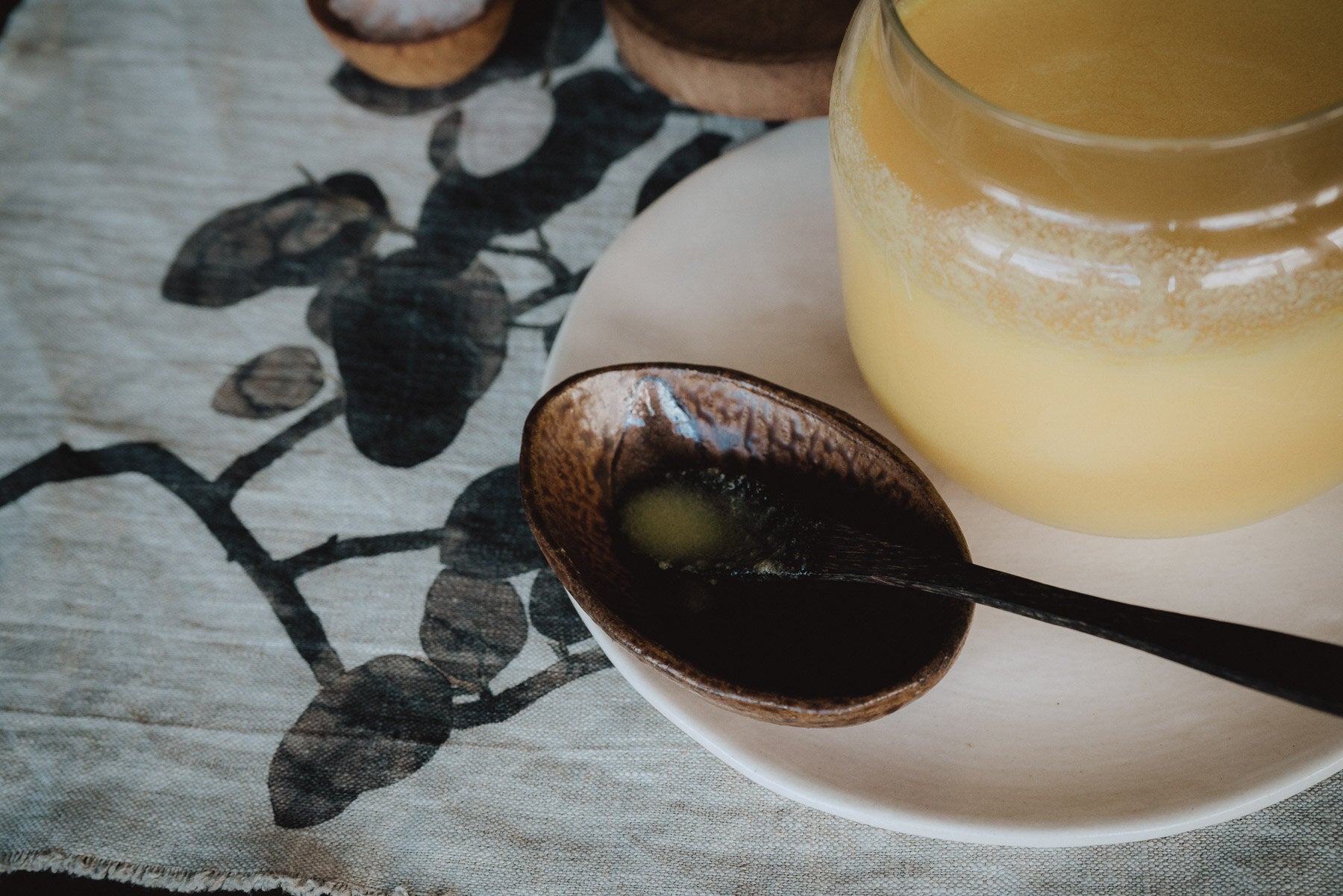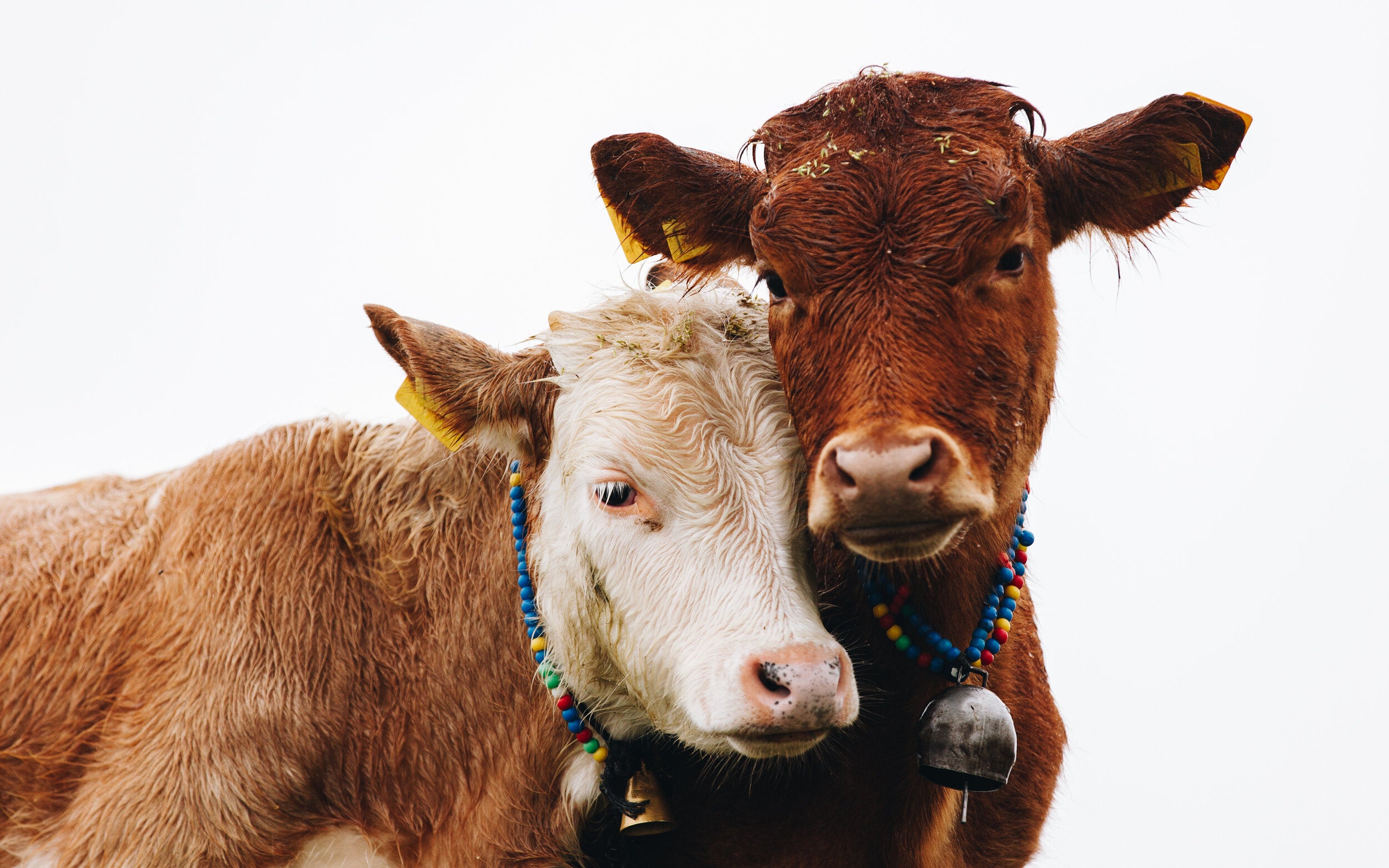
Can I be a vegan and still practice Ayurveda?
Yes! Ayurveda will meet you where you are in life. In Ayurveda we use principles that can be applied to most situations so that you can experience benefits while maintaining an approach to healing that feels right for you.
However, I think it is worthwhile to consider the value of dairy products from an Ayurvedic standpoint as a part of this month’s discussion of ahimsa - or non-violence.
Ghee, milk and buttermilk are widely recommended in Ayurvedic healing and integrating these products into my diet actually changed my whole life.
There are many reasons to follow a vegan diet - some folks are legitimately concerned with the harm brought to animals by the industrial farming process. Others find that dairy products simply don’t make them feel good. I was a vegan for almost 20 years because I had a hard time digesting dairy and I didn’t particularly like it. I also didn’t think my body needed it.
So I was vegan, and I was stiff. Very stiff - even though I was regularly practicing asana. My yoga practice took me to India to study with Patthabi Jois, which was a physically intense experience. I was complaining about the rigidity of my body to some fellow students, and they suggested that I needed to bring ghee into my diet. At that time in India they would serve a simple vegetarian meal and then come around with a pot of warm ghee to add to your food. So the next time the ghee pot came my way, I gave it a chance. And within a week I felt a notable difference. I then learned about how ghee is a fundamental part of an Ayurvedic diet because it nourishes the tissues, lubricates the joints and stokes the digestive fire. This is when my interest in Ayurveda really took off.
Over time I experienced a number of wonderful changes in my body-mind. Vata calmed which softened my mind and the way I spoke. I felt less pain in my body as I became more flexible. My digestion improved significantly.
Why does ghee play such a big role in Ayurvedic healing?
When a person is challenged by the course of life, outside stressors will often result in digestive disturbance. And Ayurveda views a compromised digestion as the root of all dis-ease. When I support clients as they heal their digestion I recommend ghee because it is unique in its ability to support the rejuvenative process.
Here's why:
-
In appropriate amounts, ghee will keep agni - digestive fire - burning more consistently which smoothes the process of digestion.
-
Ghee is the only oil that is augmenting, meaning that it deeply nourishes all of the tissues of the body, including the reproductive organs. The body actually absorbs ghee more easily than any other oil, which makes ghee very effective for calming vata dosha.
-
Ghee is neither heating nor cooling and thus does not provoke any of the doshas.
-
Ghee is great for the complexion, the eyes, intellect and memory.
What about milk?
I drink warm, raw milk with spices, ghee and dates every night before bed. Why? One word:
Ojas.
Cow’s milk possesses properties very similar to ojas, which is the subtle energy source of the human body. Sufficient ojas gives radiance, vitality and strength, and a lack of it means physical weakness, mental distress and depletion.
Here’s my nightly milk recipe and a deeper discussion of the role of cow’s milk in Ayurveda. And here is a recipe for Ayurvedic date cups - my new favourite way to boost Ojas.
And buttermilk?
Buttermilk, or takra, is a natural probiotic that offers wonderful support to the digestion. I am not referring to the mass-produced buttermilk that you will find in the grocery store. Takra comes from fresh butter or may be cultured, and it is a source of friendly bacteria that will gently heal your intestinal tract. Well-balanced intestinal flora means strong immunity. This is key.
At Hale Pule we enjoy buttermilk cut in half with water, a little ghee and spices, at least 3 times a week. We also sometimes mix it in with our vegetables. Our buttermilk is made from raw milk that we receive with great appreciation from a conscious local farmer.
But can I still practice ahimsa and consume dairy?
This is a great question, and one that comes up regularly for me when counseling clients.
Ahimsa means non-violence, which is the same thing as choosing to act with kindness, consideration and respect. Some people take this to mean that they can never take action that might harm a living thing. But sometimes action is necessary, and sometimes harm in the short-term brings sweetness in the long-term.
We encounter this on Durga Farms - sometimes we need to pull weeds so that plants that produce healing food can flourish. Other times we need to step in and remove invasive species that would otherwise choke out native populations of plants and animals. Is this wrong? Well, take a look at nature. Nature is always seeking balance. When something in nature gets way out of line, eventually we will see nature take a corrective measure of some kind. As a farmer you step into that process. As an Ayurvedic farmer, you observe the flow and the laws of nature and you implement these processes into your own methods as best you can. You become a participant in the circle of life - the process of creation and destruction.
When considering the principle of ahimsa it always comes down to being honest with yourself about your motive to act. Action rooted in ignorance, indifference or fear will yield unfavourable consequences. Action taken from a place of love, with consideration for the greater whole will have a very different effect. Herein lies the concept of karma or cause and effect.
When considering this question I think it’s useful to reflect on the Bhagavad Gita. The Gita is a foundational text in Yoga philosophy, and it asks us to look at the actual motives for our actions. Sometimes we tell ourselves that we are doing the right thing and thinking of others when we take a certain course of action, but deep down we are actually more concerned with having others think well of us.
So not only do we want to come to know ourselves well so that we can be honest with ourselves, but this process of self-study, or swadhyaya, gives us an opportunity to consciously cultivate deeply positive motives in our actions. This is when we begin to experience our truth, and find clarity in our thoughts and actions.
Now, let’s see if we can apply ahimsa in the context of consuming dairy. First, examine the motive. In Ayurveda we are not talking about harming cows in order to gratuitously consume ice cream or chocolate milk. From an Ayurvedic standpoint we are interested in healing the body, mind and spirit by finding balance within ourselves and the world around us. We want to do this without bringing harm to milk-producing animals, and so taking care to find a good source is absolutely key.

The source matters
Traditionally in India cows were revered because of their service to mankind. They process sunlight from grass better than any other creature on earth and this means that they retain an abundance of prana which is then transferred to their milk and dung. Any toxins they consume are stored in their flesh, and so they produce pure products that are healing to humans.
This was commonly considered to be a deep and generous act of service, and for millenia cows were always to be treated with the utmost respect, and a cow’s products were consumed with reverence.
Most of the world - particularly the western world - does not sustain such a relationship with cows, or other milk-producing animals. Modern industrial techniques aimed at mass production and concerned only with profit are deeply cruel to animals. Consuming milk products from such sources for the purpose of gratification is an act of himsa - or violence.
But there are other options. There are holistic farmers who genuinely care for their animals and offer them a good life while providing a nourishing product. The more people turn away from mass production and towards such sources, the more likely we are to see change in harmful industrial practices.
Find a local farmer who gives her animals the respect they deserve - it is very important for animals to be able to move and graze freely in open spaces. Ask if the farmer will come to a formal agreement to provide a steady supply of raw milk (this is sometimes called a ‘cow share’). The best way to do this is to ask around - go to your local farmer’s market and get to know the farmers. They will point you in the right direction.
If you live in an urban area and you don’t have regular access to a farmer’s market then check out your organic options. Research the dairies and their practices - are chemicals or drugs being used? Is the milk highly processed? Homogenization is definitely something to avoid because the process alters the biochemistry of the milk which significantly challenges the digestive system.
Animals must be well treated in all areas because they deserve to live a peaceful life. And a properly cared for animal will produce milk that is easier to digest. Not surprisingly, an animal who is sedentary will produce heavy milk, while an animal that grazes will yield lighter milk.
Show appreciation
Ayurveda recommends that you bless your food before you eat it. Give thanks to the hands, the creatures and the action that was required to bring your food to you. Show respect for the animals in your life - if you keep animals as pets, a nice way to do this is to feed them before you eat. Each night I serve a little warm milk for my dogs before I enjoy mine.
My aim with this article is not to convince you to abandon veganism if you feel it is important to you. Rather, I encourage you to always consider your motive for your actions, and stay open to new ideas and possibilities in life. No matter what you consume, do so with appreciation and reverence. These are key elements in ahimsa, and in maintaining a peaceful relationship with the world around us, including the animals and plants.
